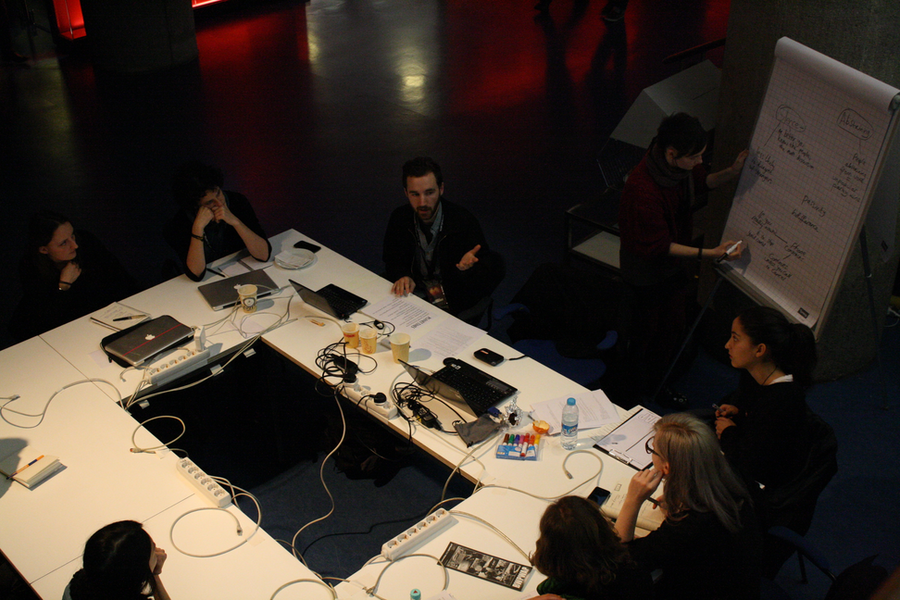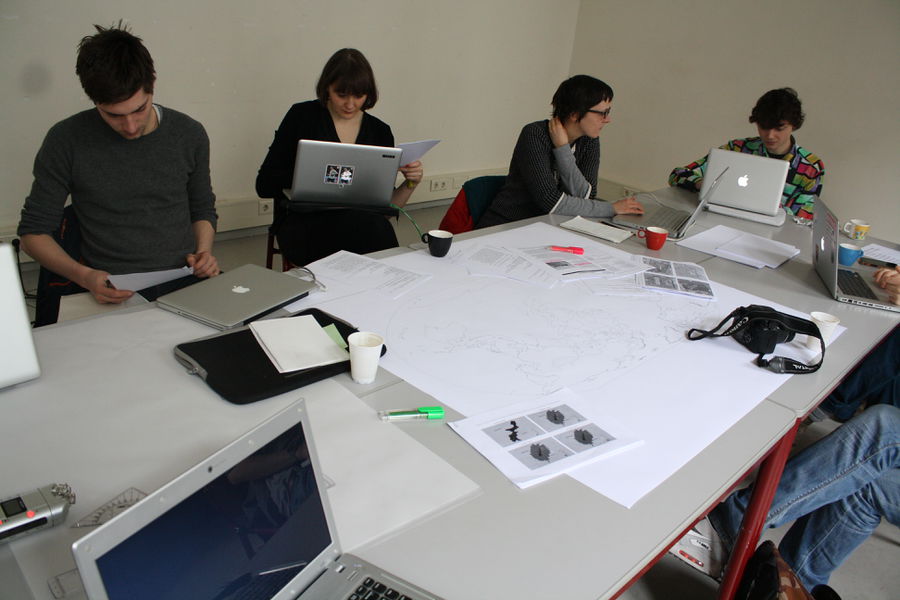User:Dave Young/Trimester5 Overview
Trimester 5 overview
This page is a quick overview of workshops I've facilitated over the course of the trimester, while working toward a final version of my graduation project.
Transmediale: Consent To Print
Eleanor Greenhalgh and I hosted a workshop on the topic of collaborative publishing as part of Transmediale's Post-Digital Print thread. I was interested in the social systems that are used to constrain collaborative creative processes, and in particular how they often fail to function. My first trimester had involved looking into critiques of cybernetic views of society - i.e. the reduction of the complexity of human behaviour to information modulated by feedback loops, and I had become interested in how this notion plays out when a group is a given the task of designing a particular tool.
An extract from my blog report on the festival can be found below:
One particularly interesting point raised by the workshop participants was how ‘silence’ fits into consensus systems. In many instances (including contemporary democracy), silence takes the form of abstinence, meaning that you forego your vote/opinion and cede power to the majority. But how can we render silence to be an active political stance, rather than passive disengagement? One participant gave the example of a telephone contract, where silence is seen as consent to extend the contract – if you don’t want your bill to continue, you must expressly state so as your contract is ending. A second participant spoke about how, during an election in her home country, many people abstained from the voting process due to a feeling of disillusionment with the political system. The result was that, while both primary parties were considered badly by the public, the worse of the two actually got into power. So, the question returns – how can a position of silence actively engage with a democratic system?
The full blog post can be accessed here.
Collisions
In February I presented Yet Another Collaborative Editor during the Collisions event at Constant in Brussels. The three-day event was about exploring conflict in various instances, from collaborative practice to cartographic design. I ran two workshops with the editor, challenging participants to work together on an empirical definition of territory that they could all agree on. The intrusiveness of the voting interface caused a predictable frustration but also a competitiveness between the participants, with some almost taking personal offence if their additions were removed.
I chose to attempt a definition of territory as I was becoming increasingly interested in how control is manifested spatially. Territorial demarcation defines autonomy (de jure and de facto, that is, a legal autonomy and a practical autonomy), an ability to control yourself. In what many scholars would call a post-national age, how difficult is it to define territory? And what territorial demarcations arise if a group attempts such a difficult task?
This was also the point where I decided to follow my observations of control systems externally. To be more precise, I decided I wanted to facilitate workshops on the same topics as before, but not direct my attention on the social interactions and emergent hierarchies of the participants - instead looking at how control functions through definitions of national territory. I had begun to investigate American imperialism during the 20th century, how that was fitting into the Cold War, containment as a military policy, and the war science cybernetics.
Reposition Matrix
The event began with an introduction to drone warfare via a history of cybernetics, the Cold War, and asymmetric warfare. This last point - asymmetry - was positioned as the central concept of the workshop: post 9-11, this assymetry of guerrilla terrorism vs monolithic military institutions has become particularly apparent. The use of UAVs is partially an attempt to address this imbalance, as it enables the US military to adopt high-tech/low-cost guerrilla tactics.
The aim of the research session was to address the new asymmetries created by the prevalence of drone warfare by mapping the locations, organisations, and technologies heavily involved within it. Through this reterritorialisation of drone warfare, we can begin to question why flying a UAV over 'enemy territory' to kill a suspected terror threat is not considered a declaration of war, as it might be if the same task would be if it were carried out by ground troops.
The research began via the distribution of a dossier of gathered materials, including RAND research on the effects of drone warfare on militant activity, a list of lat/lon coordinates of a number of airbases used for drones, and embassy cables made available by Wikileaks that refer to international UAV tech trading.
This first session posed a number of potential sources of investigation in subsequent events, particularly the industrial production and trading networks of UAV technology.
A more detailed report can be found on the project wiki here.


